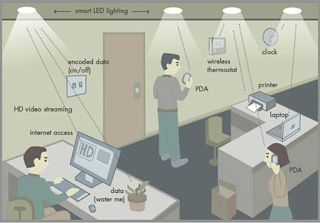 Hope to hear a ton more about
Li-Fi - a remote innovation that transmits rapid information utilizing obvious
light correspondence (VLC) - in the coming months. With researchers
accomplishing rates of 224 gigabits for every second in the lab utilizing Li-Fi
prior this year, the potential for this innovation to change everything about
the way we utilize the Internet is gigantic.
Hope to hear a ton more about
Li-Fi - a remote innovation that transmits rapid information utilizing obvious
light correspondence (VLC) - in the coming months. With researchers
accomplishing rates of 224 gigabits for every second in the lab utilizing Li-Fi
prior this year, the potential for this innovation to change everything about
the way we utilize the Internet is gigantic.
Also, now, researchers have taken
Li-Fi out of the lab surprisingly, trialing it in workplaces and mechanical
situations in Tallinn, Estonia, reporting that they can accomplish information
transmission at 1 GB for every second - that is 100 times quicker than flow
normal Wi-Fi speeds.
"We are doing a couple pilot
ventures inside diverse commercial enterprises where we can use the VLC
(obvious light correspondence) innovation," Deepak Solanki, CEO of
Estonian tech organization, Velmenni, told IBTimes UK.
"At present we have composed
a brilliant lighting answer for a mechanical situation where the information
correspondence is done through light. We are additionally doing a pilot venture
with a private customer where we are setting up a Li-Fi system to get to the
Internet in their office space."
Li-Fi was designed by Harald Haas
from the University of Edinburgh, Scotlandback in 2011, when he showed
interestingly that by flashing the light from a solitary LED, he could transmit
much more information than a cell tower. Recollect that lab-based record of 224
gigabits for every second - that is 18 films of 1.5 GB each being downloaded each
and every second.
The innovation utilizes Visible
Light Communication (VLC), a medium that uses noticeable light somewhere around
400 and 800 terahertz (THz). It works essentially like an unfathomably
propelled type of Morse code - simply like exchanging a light on and off as per
a sure example can transfer a mystery message, flicking a LED on and off at
amazing rates can be utilized to compose and transmit things in paired code.
Keeping in mind you may be
agonized over how all that glimmering in an office situation would make you
insane, don't stress - we're talking LEDs that can be exchanged on and off at
rates subtle to the exposed eye.
The advantages of Li-Fi over
Wi-Fi, other than conceivably much quicker speeds, is that on the grounds that
light can't go through dividers, it makes it a ton more secure, and as Anthony
Cuthbertson focuses out at IBTimes UK, this likewise means there's less
impedance between gadgets.
While Cuthbertson says Li-Fi will
most likely not totally supplant Wi-Fi in the coming decades, the two
advancements could be utilized together to accomplish more effective and secure
systems.
Our homes, workplaces, and
industry structures have as of now been fitted with base to give Wi-Fi, and
tearing the majority of this out to supplant it with Li-Fi innovation isn't
especially possible, so the thought is to retrofit the gadgets we have at this
time to work with Li-Fi innovation.
Examination groups the world over
are chipping away at simply that. Li-Fi expertsreported for The Conversation a
month ago that Haas and his group have propelled PureLiFi, an organization that
offers an attachment and-play application for secure remote Internet access
with a limit of 11.5 MB for each second, which is similar to original Wi-Fi.
Furthermore, French tech organization Oledcomm is currently introducing its own
Li-Fi innovation in nearby healing facilities.
On the off chance that
applications like these and the Velmenni trial in Estonia demonstrate fruitful,
we could accomplish the fantasy laid out by Haas in his 2011 TED talk beneath -
everybody accessing the Internet by means of LED lights in their home.
"We should do nothing more
than fit a little microchip to every potential enlightenment gadget and this
would then join two fundamental functionalities: brightening and remote
information transmission," Haas said. "Later on we won't just have 14
billion lights, we may have 14 billion Li-Fis conveyed worldwide for a cleaner,
greener, and much brighter future."
